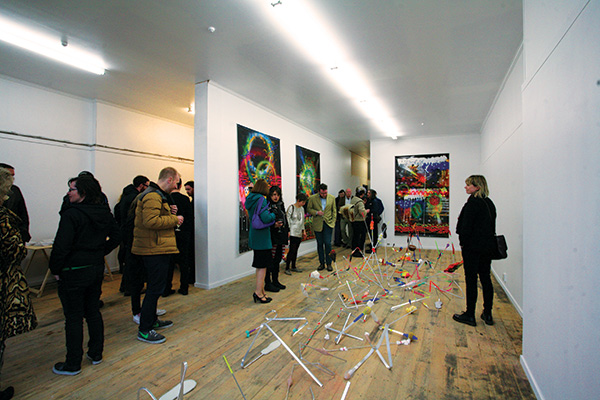Blue Oyster
Established in 1999, the Blue Oyster Art Project Space is a programme that fosters contemporary and experimental art practice within Dunedin. Designed to “broaden interest [in] and understanding of contemporary art,” the space affords artists the freedom to experiment fully, and remains strictly not-for-profit, going so far as to reject outright any clearly commercial projects.
The new gallery also has a designated room at the back for research, and in the past has held many panel discussions over artistic items of interest. Blue Oyster is therefore a novel concept, extending the notion of a gallery beyond being a place that promotes and sells art.
Blue Oyster used to be underground, literally as well as figuratively. While being located down an alleyway is an interesting feature, it had the unfortunate consequence of depriving the gallery of any natural light. The gallery’s new space, entirely fronted by a full-glass window, is thus a dramatic improvement; not only is it flooded with light that doesn’t come from a dangling fluorescent bulb, it now attracts an unprecedented amount of foot traffic.
During the 10 minutes I was there, about three groups of people stopped walking to look through the window. Perhaps the next challenge should be making the entrance more welcoming, so that anyone feels comfortable walking through the door. In saying that, however, the window does provide enough of a glimpse that being in the room may not even be necessary.
Judy Darragh has the honour of being the first artist to display work at Blue Oyster. Pinewood Bend 2013 consists of twisted pieces of metal composed along the middle of the not-yet-varnished floor, garnished with pieces of fluorescent tape and spray paint, the tips bandaged with fabric and pieces of foam. It manages to exude a sense of simultaneous density and flimsiness. Referencing the progression of life, it evolves both in colour and in scope: neutral colours become bright neons, and the low-lying metal structure becomes tall spikes sporting various shoe insoles.
The work stays true to her distinctive kitsch style, but while a crowded room never works in an artwork’s favour, many people I’ve spoken to who attended the opening were more impressed by the galactic adaptions of Denzel Washington movie posters with neon spray paint. The continuity of both theme and style across the various works, however, combined with a clear attention to detail, made the exhibition more powerful than second-hand descriptions had led me to believe.
Located right next door to Les Mills, not only does Blue Oyster offer fitness buffs a taste of art alongside their workout, it makes the entire street the art hub of the city. Next to Milford Galleries and up the road from Brett McDowell (two galleries known for their vibrant openings), the Dunedin art scene is increasingly becoming a real community.
The gallery isn’t even finished yet, and there is plenty of exiting potential yet to be realised. Darrah’s bright works are an appropriate reflection of the thought-provoking art to come, and perfectly signposts the gallery’s new direction. Director Jamie Hanton described the space as a “dream came true,” and it’s easy to see why. Its raving opening may well be the hook needed to convince students to tap into Dunedin’s vibrant art scene. Watch this space.



